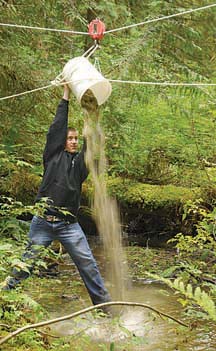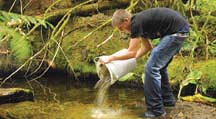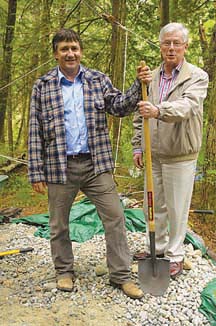Sea Cadets help salmon
Gravel restored at Myrtle Creek
By Esther Dyck
 Coho salmon returning to spawn in Myrtle Creek this year will find some ideal new habitat, thanks to the efforts of local volunteers and the Pacific Salmon Foundation.
Coho salmon returning to spawn in Myrtle Creek this year will find some ideal new habitat, thanks to the efforts of local volunteers and the Pacific Salmon Foundation.
The Foundation gave the Myrtle Creek Steward Society a grant for habitat restoration in 2009. A portion of the grant funds was used in early September for a Coho spawning gravel project and the remaining monies will be used for more restoration work next year.
Myrtle Creek is a wild coho stream located just minutes south of town and is fed from natural springs and Hammil Lake. The Creek meanders 14 kilometres through farmland, wetlands, forest and canyons to Pebble Beach where it meets the ocean. It has a strong year-round flow and cool temperature which is perfect for the populations of coho salmon and chum salmon, cutthroat trout, two species of sculpin, lamprey eels, as well as bears and cougars. The natural habitat and tea coloured water make it an ideal laboratory for the study of marine species, in particular coho salmon. The coho stocks in Myrtle Creek are completely wild so they serve as an important source of data used to give indication of survival rates for other wild salmon on the mainland coast.
 Although Myrtle is a unique creek it has typical problems. Running through private property and private managed forest land, residents and developers are often unaware of the significance of the stream and their obligation to do no damage to the stream or its fish habitat. Logging on both private and crown land can have major impacts, creating silt run-off that builds up and eventually covers the floor of the entire creek, destroying salmon habitat. The object of this restoration project was to introduce new gravel.
Although Myrtle is a unique creek it has typical problems. Running through private property and private managed forest land, residents and developers are often unaware of the significance of the stream and their obligation to do no damage to the stream or its fish habitat. Logging on both private and crown land can have major impacts, creating silt run-off that builds up and eventually covers the floor of the entire creek, destroying salmon habitat. The object of this restoration project was to introduce new gravel.
 Wayne Logan gave permission to use his beautiful property to access Myrtle Creek for this year's habitat restoration. Low elevation reaches are absolutely critical for spawning and rearing of young salmon, Wayne's property has such a perfect habitat site on the creek. The object of this project was to provide new spawning gravel to help repair the silted beds.
Wayne Logan gave permission to use his beautiful property to access Myrtle Creek for this year's habitat restoration. Low elevation reaches are absolutely critical for spawning and rearing of young salmon, Wayne's property has such a perfect habitat site on the creek. The object of this project was to provide new spawning gravel to help repair the silted beds.
The project was planned to have the least possible impact on a very pristine natural environment. Spawning gravel was placed in the creek in true seamanship style via an amazing jackstay transfer system of ropes and pulleys which hauled the heavy gravel buckets--organized and set up by David Dyck.
The Powell River Sea Cadets volunteered for the hard work of shovelling, moving and placing the gravel. These wonderful young people worked diligently and professionally under the direction and watchful eye of Lt (N) Dave McLennan, Commander.
With this restoration project and the one being planned for next year, we will see good results in only a few years. The work of the cadets to preserve and restore an aquatic ecosystem for present and future generations encourages us all to do the same.